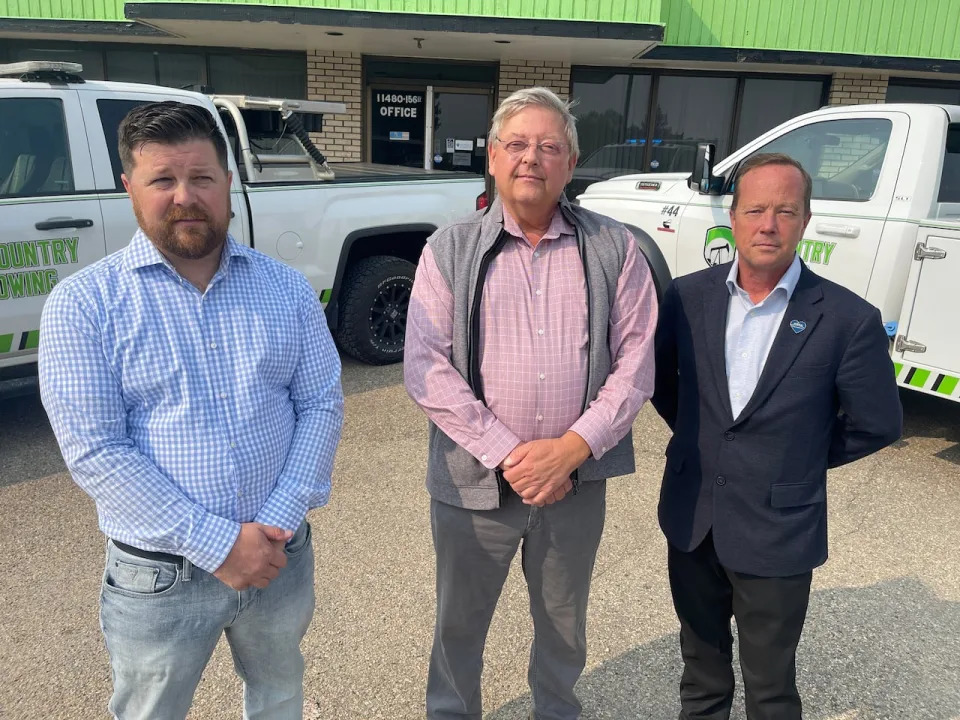Paramedics, tow truck drivers criticize Alberta's diluted safety legislation for roadside workers
NDP Transportation critic tells UCP to put Friday's roll-out on hold and go back to the original set of rules, which are the norm in most Canadian provinces
CBC
Fri, September 1, 2023

Don Getschel, president of the Towing and Recovery Association of Alberta, stands next to one of his company's trucks on Friday. (Travis McEwan/CBC - image credit)
Tow truck drivers and paramedics are joining the voices criticizing the provincial government for walking back some of new traffic safety provisions intended to protect roadside workers.
The original version of the 2022 legislation, which amended the Traffic Safety Act, required drivers in every lane going in the same direction to reduce their speed to 60 kilometres per hour when passing a roadside worker's vehicle with its flashing lights on. Drivers on two-lane highways were required to slow to 60 in both directions.
Earlier this month, Transportation Minister Devin Dreeshen announced the speed limit change would come into effect on Sept. 1, but would only apply to drivers in the lane closest to the roadside worker.
Mike Parker, the president of the Health Sciences Association of Alberta, and Don Getschel, president of the Towing and Recovery Association of Alberta said Friday he thinks the new rules are dangerous for everyone on the road.
They said people driving 60 could be rear-ended by other drivers going nearly twice the speed when they change lanes.
"This creates unnecessary risk for the motoring public and for us as workers on the roadside," Getschel said at an NDP news conference in Edmonton, the same day the new rules come into effect.
Getschel, who owns a towing company with an office in Leduc, said his operators have seen 14 major collisions over 12 years. Two were so serious that the operators were taken to hospital in an ambulance, he said.
"We were hoping that this change would be a positive thing for our industry, but unfortunately that didn't happen," he said.
Jesse Furber, press secretary for Dreeshen, said in an email to CBC News that it was safer for vehicles in the outside lanes to keep a consistent highway speed.
"Some Alberta roads have up to five lanes, and having five lanes slow down to 60km/h will create a sudden bottleneck increasing the risk of sudden or improper braking leading to a higher risk of rear-end collisions," he wrote. "It is also the case that drivers in the far lane often cannot see that a vehicle is stopped on the shoulder multiple lanes across from them.
'In the winter, this becomes even more unsafe as it takes up to 10 times longer to stop on snow and ice than it does on dry pavement."
Furber said drivers aren't expected to change lanes away from stopped roadside vehicles if it isn't safe to do so. They are required to go 60 km/hr or the posted speed if it is lower.
The old rules required drivers in the adjacent lane to slow to 60 km/hr when passing an emergency vehicle, tow trucks and construction crews when vehicle lights were flashing.
In addition to requiring drivers in all lanes to slow down, the amendments to the Traffic Safety Act passed by the Alberta legislature in 2022 extended the rule to snowplows and maintenance crews.
The 2022 regulations were supposed to come into effect in March but were put on hold. At the time, the government said it needed to release a two- to three-month campaign to educate drivers.

Don Getschel, president of the Towing and Recovery Association of Alberta (left), Lorne Dach, NDP Transportation critic, and Mike Parker, president of the Health Sciences Association of Alberta, want the province to require drivers in all lanes to slow to 60 km/hr when passing a roadside vehicle with flashing lights.
Don Getschel, president of the Towing and Recovery Association of Alberta (left), Lorne Dach, NDP Transportation critic, and Mike Parker, president of the Health Sciences Association of Alberta, want the province to require drivers in all lanes to slow to 60 km/hr when passing a roadside vehicle with flashing lights. (Travis McEwan/CBC)
In early August, Dreeshen announced the Sept. 1 start date. It was only then that the media and groups like the Alberta Motor Association noticed the regulations were different.
Parker, whose union represents Alberta paramedics, said HSAA was not consulted about the change. He said the government needs to get everyone passing a roadside vehicle to slow to 60 regardless of what lane they're in.
"When there's an incident with the emergency lights on the side of the highway, everybody slows down," he said. "It's that simple .Now you've got multiple lanes doing 110 and 120, one lane trying to do 60. This is the chaos."
NDP Transportation critic Lorne Dach wants Dreeshen to put Friday's roll-out on hold and go back to the original set of rules, which are the norm in most Canadian provinces.
NDP Transportation critic tells UCP to put Friday's roll-out on hold and go back to the original set of rules, which are the norm in most Canadian provinces
CBC
Fri, September 1, 2023

Don Getschel, president of the Towing and Recovery Association of Alberta, stands next to one of his company's trucks on Friday. (Travis McEwan/CBC - image credit)
Tow truck drivers and paramedics are joining the voices criticizing the provincial government for walking back some of new traffic safety provisions intended to protect roadside workers.
The original version of the 2022 legislation, which amended the Traffic Safety Act, required drivers in every lane going in the same direction to reduce their speed to 60 kilometres per hour when passing a roadside worker's vehicle with its flashing lights on. Drivers on two-lane highways were required to slow to 60 in both directions.
Earlier this month, Transportation Minister Devin Dreeshen announced the speed limit change would come into effect on Sept. 1, but would only apply to drivers in the lane closest to the roadside worker.
Mike Parker, the president of the Health Sciences Association of Alberta, and Don Getschel, president of the Towing and Recovery Association of Alberta said Friday he thinks the new rules are dangerous for everyone on the road.
They said people driving 60 could be rear-ended by other drivers going nearly twice the speed when they change lanes.
"This creates unnecessary risk for the motoring public and for us as workers on the roadside," Getschel said at an NDP news conference in Edmonton, the same day the new rules come into effect.
Getschel, who owns a towing company with an office in Leduc, said his operators have seen 14 major collisions over 12 years. Two were so serious that the operators were taken to hospital in an ambulance, he said.
"We were hoping that this change would be a positive thing for our industry, but unfortunately that didn't happen," he said.
Jesse Furber, press secretary for Dreeshen, said in an email to CBC News that it was safer for vehicles in the outside lanes to keep a consistent highway speed.
"Some Alberta roads have up to five lanes, and having five lanes slow down to 60km/h will create a sudden bottleneck increasing the risk of sudden or improper braking leading to a higher risk of rear-end collisions," he wrote. "It is also the case that drivers in the far lane often cannot see that a vehicle is stopped on the shoulder multiple lanes across from them.
'In the winter, this becomes even more unsafe as it takes up to 10 times longer to stop on snow and ice than it does on dry pavement."
Furber said drivers aren't expected to change lanes away from stopped roadside vehicles if it isn't safe to do so. They are required to go 60 km/hr or the posted speed if it is lower.
The old rules required drivers in the adjacent lane to slow to 60 km/hr when passing an emergency vehicle, tow trucks and construction crews when vehicle lights were flashing.
In addition to requiring drivers in all lanes to slow down, the amendments to the Traffic Safety Act passed by the Alberta legislature in 2022 extended the rule to snowplows and maintenance crews.
The 2022 regulations were supposed to come into effect in March but were put on hold. At the time, the government said it needed to release a two- to three-month campaign to educate drivers.

Don Getschel, president of the Towing and Recovery Association of Alberta (left), Lorne Dach, NDP Transportation critic, and Mike Parker, president of the Health Sciences Association of Alberta, want the province to require drivers in all lanes to slow to 60 km/hr when passing a roadside vehicle with flashing lights.
Don Getschel, president of the Towing and Recovery Association of Alberta (left), Lorne Dach, NDP Transportation critic, and Mike Parker, president of the Health Sciences Association of Alberta, want the province to require drivers in all lanes to slow to 60 km/hr when passing a roadside vehicle with flashing lights. (Travis McEwan/CBC)
In early August, Dreeshen announced the Sept. 1 start date. It was only then that the media and groups like the Alberta Motor Association noticed the regulations were different.
Parker, whose union represents Alberta paramedics, said HSAA was not consulted about the change. He said the government needs to get everyone passing a roadside vehicle to slow to 60 regardless of what lane they're in.
"When there's an incident with the emergency lights on the side of the highway, everybody slows down," he said. "It's that simple .Now you've got multiple lanes doing 110 and 120, one lane trying to do 60. This is the chaos."
NDP Transportation critic Lorne Dach wants Dreeshen to put Friday's roll-out on hold and go back to the original set of rules, which are the norm in most Canadian provinces.
No comments:
Post a Comment